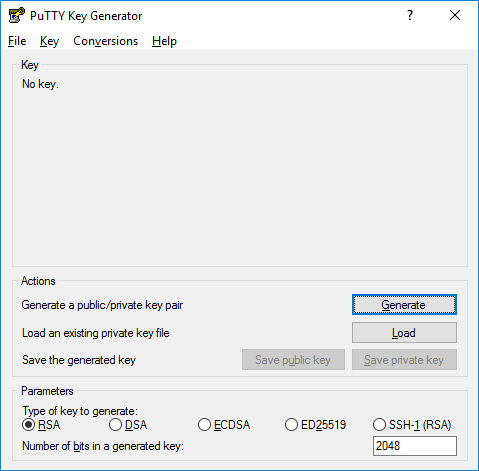Android Generate Public Private Key
- Android Generate Public Private Keyboard
- Generate Public Private Key Pair
- Android Generate Public Private Key Pair
- Android Generate Public Private Key Explained
- Android Generate Public Private Key Example
May 13, 2019 In Public key, two keys are used one key is used for encryption and another key is used for decryption. One key (public key) is used for encrypt the plain text to convert it into cipher text and another key (private key) is used by receiver to decrypt the cipher text to read the message. Mar 03, 2020 This page explains how to generate public/private key pairs using OpenSSL command-line tools. Device authentication. Cloud IoT Core uses public key (or asymmetric) authentication: The device uses a private key to sign a JSON Web Token (JWT). The token is passed to Cloud IoT Core as proof of the device's identity. I can generate a public/private keypair at the Android device upon first start of the app, and securely store them in the internal storage, but I need to find a way to send the generated public key of the Android device to my server, so my server can encrypt the data with it. Generate a new secret key. To generate the key, follow the same process as the one for generating a new private key. You use the Security library in each case. Import encrypted keys more securely. Android 9 (API level 28) and higher allow you to import encrypted keys securely into the Keystore using an ASN.1‑encoded key format.
Nov 01, 2018 The code snippet below show you how to use the JDK Security API to generate public and private keys. A private key can be use to sign a document and the public key is use to verify that the signature of the document is valid.
The integrity of the fingerprint authentication results is important to an application – it is how the application knows the identity of the user. It is theoretically possible for third-party malware to intercept and tamper with the results returned by the fingerprint scanner. This section will discuss one technique for preserving the validity of the fingerprint results.
The FingerprintManager.CryptoObject is a wrapper around the Java cryptography APIs and is used by the FingerprintManager to protect the integrity of the authentication request. Typically, a Javax.Crypto.Cipher object is the mechanism for encrypting the results of the fingerprint scanner. The Cipher object itself will use a key that is created by the application using the Android keystore APIs.
To understand how these classes all work together, let's first look at the following code which demonstrates how to create a CryptoObject, and then explain in more detail:
The sample code will create a new Cipher for each CryptoObject, using a key that was created by the application. The key is identified by the KEY_NAME variable that was set in the beginning of the CryptoObjectHelper class. The method GetKey will try and retrieve the key using the Android Keystore APIs. If the key does not exist, then the method CreateKey will create a new key for the application.
The cipher is instantiated with a call to Cipher.GetInstance, taking a transformation (a string value that tells the cipher how to encrypt and decrypt data). The call to Cipher.Init will complete the initialization of the cipher by providing a key from the application.
It is important to realize that there are some situations where Android may invalidate the key:
- A new fingerprint has been enrolled with the device.
- There are no fingerprints enrolled with the device.
- The user has disabled the screen lock.
- The user has changed the screen lock (the type of the screenlock or the PIN/pattern used).
When this happens, Cipher.Init will throw a KeyPermanentlyInvalidatedException. The above sample code will trap that exception, delete the key, and then create a new one.

The next section will discuss how to create the key and store it on the device.
Creating a Secret Key

The CryptoObjectHelper class uses the Android KeyGenerator to create a key and store it on the device. The KeyGenerator class can create the key, but needs some meta-data about the type of key to create. This information is provided by an instance of the KeyGenParameterSpec class.
Android Generate Public Private Keyboard
A KeyGenerator is instantiated using the GetInstance factory method. The sample code uses the Advanced Encryption Standard (AES) as the encryption algorithm. AES will break the data up into blocks of a fixed size and encrypt each of those blocks.
Next, a KeyGenParameterSpec is created using the KeyGenParameterSpec.Builder. The KeyGenParameterSpec.Builder wraps the following information about the key that is to be created:
Generate Public Private Key Pair
- The name of the key.
- The key must be valid for both encrypting and decrypting.
- In the sample code the
BLOCK_MODEis set to Cipher Block Chaining (KeyProperties.BlockModeCbc), meaning that each block is XORed with the previous block (creating dependencies between each block). - The
CryptoObjectHelperuses Public Key Cryptography Standard #7 (PKCS7) to generate the bytes that will pad out the blocks to ensure that they are all of the same size. SetUserAuthenticationRequired(true)means that user authentication is required before the key can be used.
Once the KeyGenParameterSpec is created, it is used to initialize the KeyGenerator, which will generate a key and securely store it on the device.
Openssl req -new -key server.key -out server.csr -sha256Where server is the name of your server.As you are prompted, enter the following information:For fields that are not required, you can enter '.' For a comprehensive listing of default installation layouts for Apache HTTPD on various operating systems and distributions, see.Often, the SSL Certificate configuration is located in a block in a different configuration file. Possible locations for this file include /etc/httpd/ or /etc/apache2/. The location and name of the config file can vary from server to server - especially if you use a special interface to manage your server configuration.Apache's main configuration file is typically named httpd.conf or apache2.conf. Generate ecc key pair android.
Using the CryptoObjectHelper
Now that the sample code has encapsulated much of the logic for creating a CryptoWrapper into the CryptoObjectHelper class, let's revisit the code from the start of this guide and use the CryptoObjectHelper to create the Cipher and start a fingerprint scanner:
Now that we have seen how to create a CryptoObject, lets move on to see how the FingerprintManager.AuthenticationCallbacks are used to transfer the results of fingerprint scanner service to an Android application.
Android Generate Public Private Key Pair
Related Links
Android Generate Public Private Key Explained
Chilkat • HOME • Android™ • Classic ASP • C • C++ • C# • Mono C# • .NET Core C# • C# UWP/WinRT • DataFlex • Delphi ActiveX • Delphi DLL • Visual FoxPro • Java • Lianja • MFC • Objective-C • Perl • PHP ActiveX • PHP Extension • PowerBuilder • PowerShell • PureBasic • CkPython • Chilkat2-Python • Ruby • SQL Server • Swift 2 • Swift 3/4 • Tcl • Unicode C • Unicode C++ • Visual Basic 6.0 • VB.NET • VB.NET UWP/WinRT • VBScript • Xojo Plugin • Node.js • Excel • Go
| Android™ example code showing how to generate an RSA public/private key pair and export to PEM files. Bitcoin private key generator free download.
| |||||
© 2000-2020 Chilkat Software, Inc. All Rights Reserved.